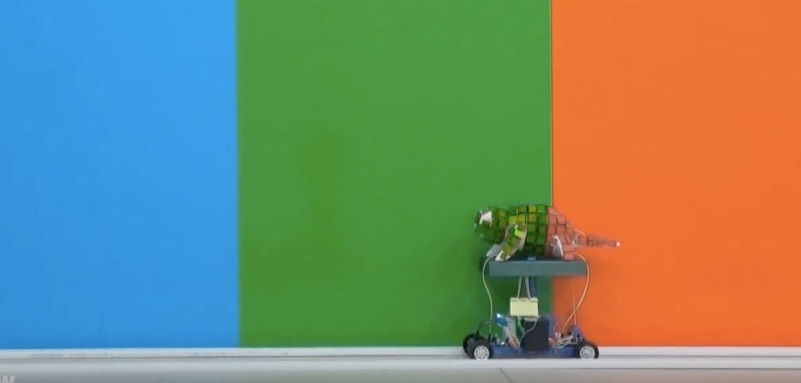It seems that some pretty cool news snuck by most of the world last month in the scientific journal ACS Nano. Perhaps it’s because it involves an actual camouflaging mechanical chameleon!
The research, which was conducted by a collaborative team from China’s Wuhan University and the Atlanta-based Georgia Institute of Technology, was aimed at reaching ‘optical invisibility’ by covering a 3D printed chameleon model in a plasmonic display. What these plasmons (aka ripples of electrons) allow for is real-time light manipulation that adapts to the color of the surrounding environment. So, as you can see in the research team’s video below, the mechanical chameleon is able to change it’s entire color almost instantaneously with the introduction of a newly colored setting. In their report entitled “Mechanical Chameleon through Dynamic Real-Time Plasmonic Tuning”, the team describes their successful efforts at fabricating “a biomimetic mechanical chameleon and an active matrix display with dynamic color rendering covering almost the entire visible region.”
According to their report , the mechanical chameleon was 3D printed in ABS using a da Vinci 1.0 3D printer, an affordable consumer-grade printer that costs just around $500 USD. The 3D printed chameleon was then completely covered with plasmonic cells, which, once linked with added color sensors, enabled the mechanical reptile to change quickly between red, blue, and green. The plasmonic display effect was achieved by covering the mechanical chameleon with small sheets of glass equipped with a grid of holes that measure a mere 50 manometers wide. The glass sheets were then coated in both a layer gold and electrolyte gel with silver ions, which together worked to successfully take the incoming light and determine the necessitated properties of the reflected and absorbed color.
“We have achieved reversible full-color plasmonic cells/display by electrochemically controlling the structure of a Au/Ag core−shell nanodome array and successfully integrated these cells onto a mechanical chameleon, which can blend automatically with colored backgrounds,” the team writes in their ACS Nano report. Using 3D printing as the foundation and body of their nanoparticle experimentation, the research team was able to successfully replicate the unique color changing ability that our little reptilian friends are so well known for.
Though the team’s mechanical chameleon is currently limited to changing between these three colors, the research itself is likely being studied hard within the military industry, who would certainly love to utilize this real-time color changing technology for camouflaging military vehicles and body armor. Regardless of the influence that this experimentation may have on modern warfare in the not-so-distant future, for now we can sit back and enjoy as this 3D printed mechanical chameleon changes the way that camouflage is used, seen, and not seen…





